A Complete Guide to Planting, Pruning and Caring for a Fig Tree
A Complete Guide to Planting and Caring for a Fig Tree
If you're ready to add an edible element to your garden oasis that will keep on giving for years, then consider planting a fig tree. Not only do these plants thrive in full and partial sunlight and many climates, but they're also fast-growing, easy to maintain, low cost – oh! And did we mention the delicious fruits?! In this blog post guide we’ll help take you through every step of the process - from selecting soil and choosing varieties right up to caring for a mature tree and harvesting fruit - so that you can reap all the benefits of having a healthy fig tree in your backyard paradise or urban abode soon!
An Overview of the Fig Tree
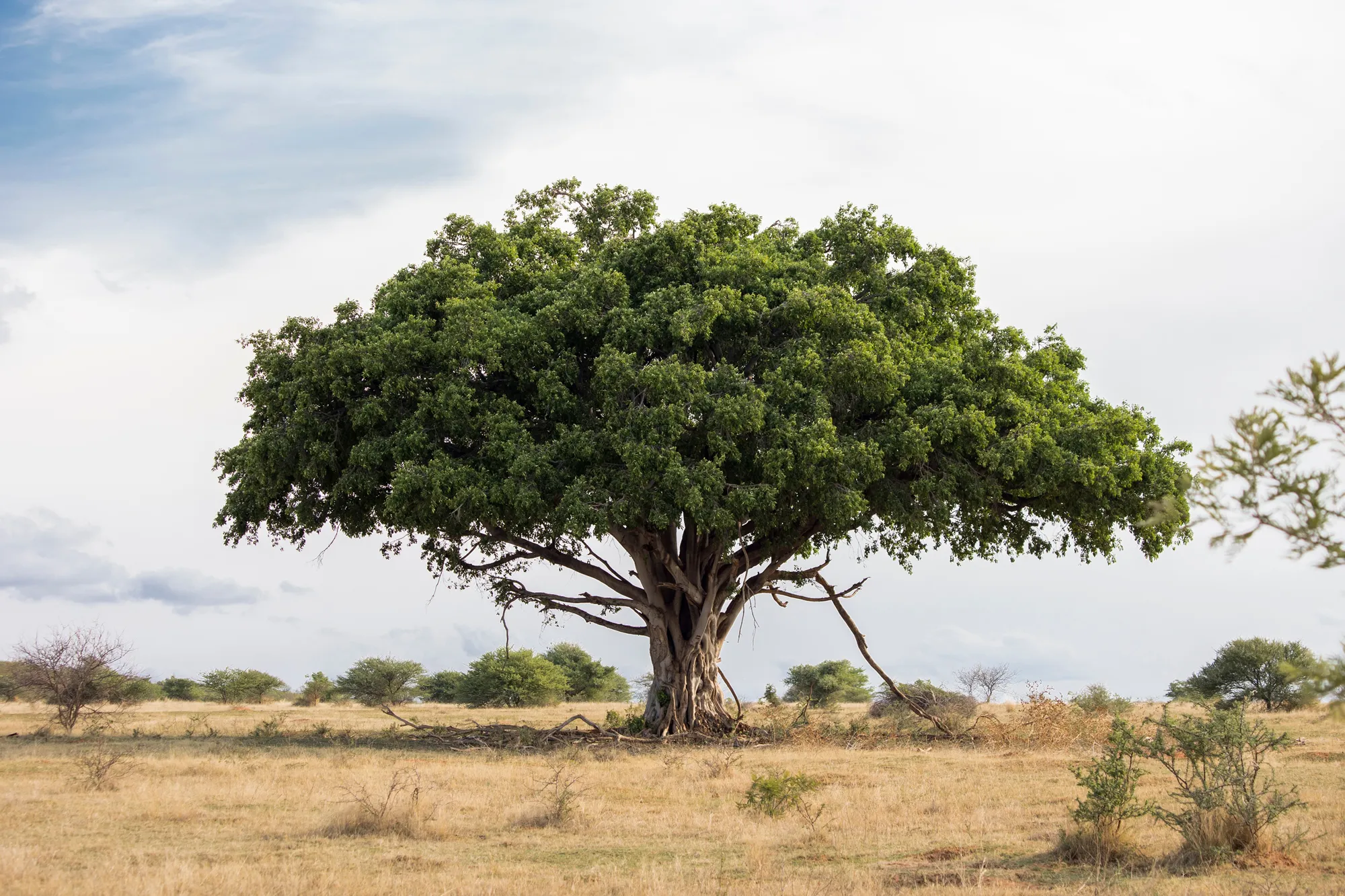 An old large Wild fig tree standing tall in the Savannah grassland
An old large Wild fig tree standing tall in the Savannah grassland
The fig tree, known by its scientific name Ficus carica, is an intriguing and unique plant that has piqued the curiosity of many throughout history. With its origins in the Middle East, the fig tree has propagated itself throughout the world, becoming a beloved fruit tree in many cultures. The tree itself has a distinctive look, featuring large leaves and thick branches that grow parallel to the ground. But what really makes the fig tree stand out is the way it produces fruit - on the inside of a fleshy "false fruit," or syconium. The fig tree's relationship with wasps is also fascinating: tiny female wasps enter the syconium to lay eggs, while simultaneously pollinating the tree's flowers. It's no wonder that the fig tree has inspired poets, artists, and writers throughout history - there's just something captivating about this plant that goes beyond its delicious fruit.
Pruning your fig tree is essential for maintaining healthy growth and producing consistent crops of delectable figs each summer season. Taking the time to learn the variety of your fig tree, understanding when and how to prune it, having the correct tools and safety gear on hand, utilizing various pruning techniques, providing post-pruning care, and avoiding common mistakes will all help ensure that you have an abundant harvest of juicy figs each year. So don’t wait any longer - get out there today, gather up your supplies, and start pruning! You won’t be disappointed with the results.
The History of the Fig Tree in the UK
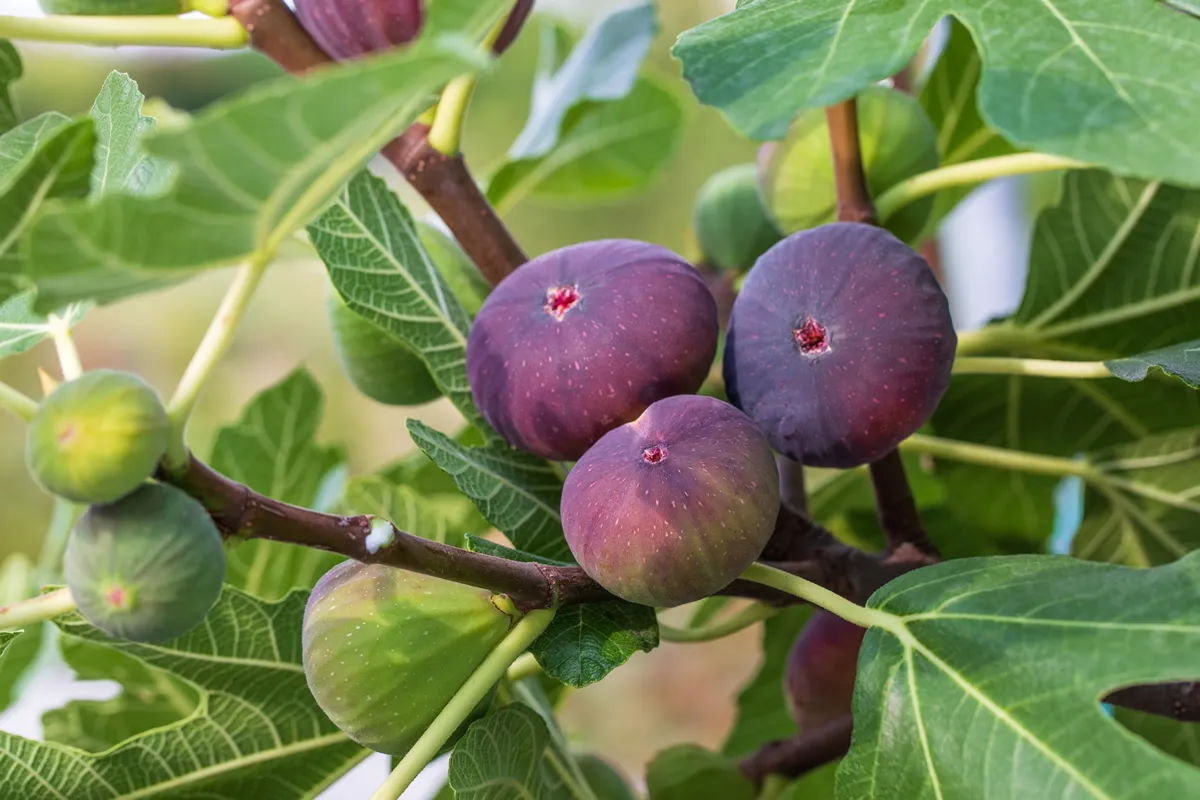 Figs fruits on the tree branch
Figs fruits on the tree branch
The history of the fig tree in the UK is a fascinating tale that spans centuries. From its introduction by the Romans, to its rise in popularity during the Tudor period, and its decline during the Industrial Revolution, the fig tree has played a significant role in gardening throughout British history. Its unique flavor and nutritional value have made it a favorite among gardeners, who often go to great lengths to cultivate and care for their fig trees. Despite facing many challenges over the years, including climate changes and disease outbreaks, the fig tree has endured and remains a beloved symbol of British gardening culture.
The fig tree (Ficus carica) has a long and fascinating history in the United Kingdom. Despite being native to the Middle East and Western Asia, it has become an iconic symbol in British gardens and landscapes. The fig tree's journey to the UK is a story of exploration, trade, and cultural exchange, which has led to its enduring presence in British horticulture.
Early Introduction
The fig tree is believed to have been introduced to the UK by the Romans around 2,000 years ago. As the Roman Empire expanded, they brought with them various plants and trees from the Mediterranean region, including the fig tree. The Romans valued figs for their taste, nutritional properties, and as a symbol of prosperity.
Although the climate in the UK was colder than the Mediterranean, the Romans discovered that the fig tree could still grow well in sheltered and sunny locations. They cultivated the trees in their villas and gardens, often planting them against south-facing walls to maximize sun exposure.
Medieval and Renaissance Periods
After the Roman Empire fell, the cultivation of fig trees in the UK declined. However, the fig tree remained a popular subject in religious and artistic symbolism. In medieval and Renaissance artwork, fig leaves were often used to cover the nudity of biblical figures, such as Adam and Eve.
During this period, fig trees began to reappear in monastic gardens and the estates of the nobility. The 16th-century herbalist and botanist John Gerard noted in his book, Herball, or Generall Historie of Plantes, that figs were grown in the gardens of England's wealthiest families. Additionally, figs were imported from the Mediterranean and dried for consumption during winter months.
18th and 19th Centuries
The 18th and 19th centuries saw a resurgence in the interest and cultivation of fig trees in the UK. This period marked the beginning of the British Empire, and trade routes with the Mediterranean and the Middle East expanded. As a result, new varieties of fig trees were introduced to the UK, and their popularity grew.
The British aristocracy and upper classes began planting fig trees as a symbol of wealth and status. The trees were often grown in orangeries and glasshouses to protect them from the colder British climate. Some of these historic fig trees can still be found today, such as the one at Syon House in West London, which is said to date back to the 18th century.
The Modern Era
In the 20th and 21st centuries, the fig tree has continued to thrive in the UK, particularly in southern and coastal regions where the climate is milder. Fig trees are now commonly found in domestic gardens, public parks, and urban landscapes, where they are appreciated for their attractive foliage and delicious fruit.
With the rise of interest in organic gardening and sustainable living, fig trees have gained even more popularity due to their low-maintenance nature and ability to produce fruit without the need for pesticides or chemical fertilizers.
In conclusion, the history of the fig tree in the UK is a testament to its adaptability, beauty, and cultural significance. From its introduction by the Romans to its modern-day presence in British gardens, the fig tree remains an iconic and cherished symbol of horticultural heritage.
Identify the right type of Fig Tree for the UK climate
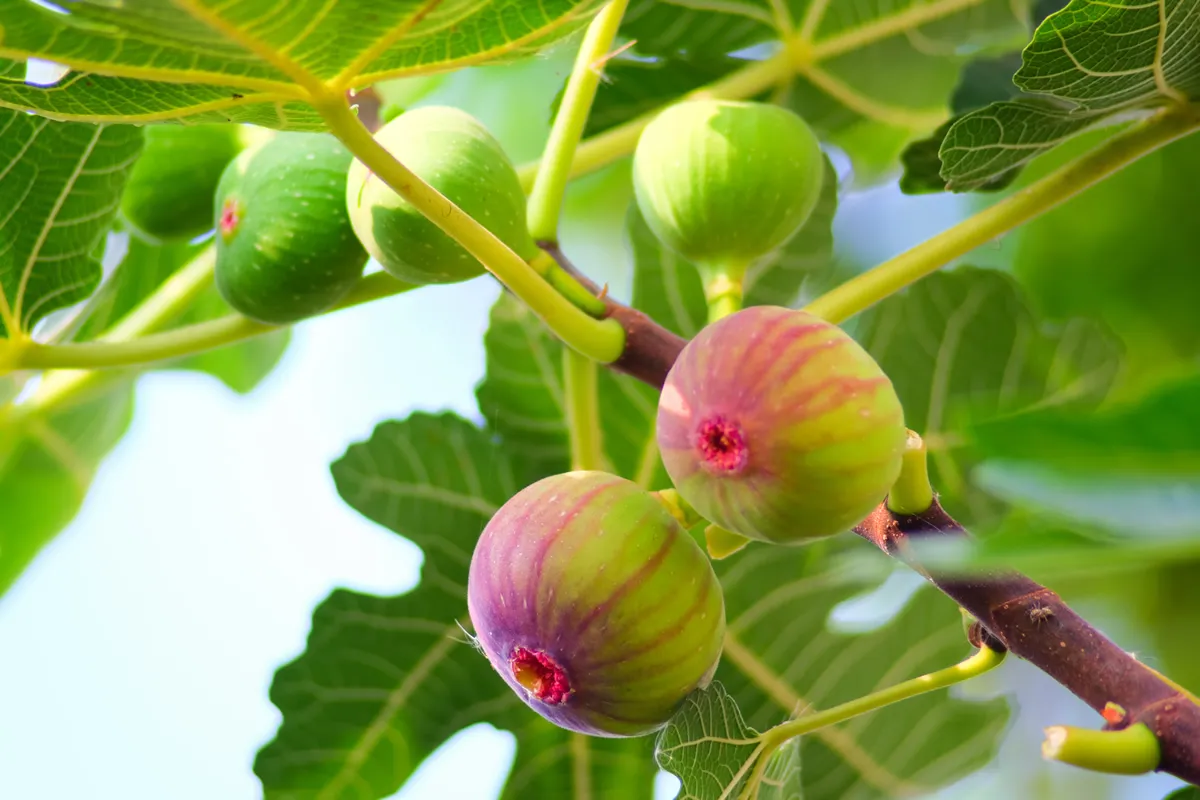 Fig fruit
Fig fruit
Fig trees have been cultivated for thousands of years, prized not only for their delicious fruit but also for their striking beauty. However, not all fig trees thrive in the UK climate, which can be challenging for some species. To make sure that you choose the right type of fig tree that will flourish in your garden, consider factors such as winter hardiness, disease resistance, and yield. For example, the Brown Turkey Fig is a popular choice for UK gardens as it is hardy, disease-resistant, and produces a reliable crop of sweet fruit. Whatever variety you choose, make sure that you follow best practices for planting, watering, and pruning to ensure that your fig tree thrives for years to come.
The UK climate can be challenging for some fig tree varieties due to its colder temperatures and shorter growing seasons. However, there are several types of fig trees well-suited for the UK climate, which can produce delicious fruit and thrive in British gardens. Here are some popular choices:
- Ficus carica 'Brown Turkey': This is one of the most popular fig varieties for the UK climate. It produces large, sweet, and juicy brownish-purple fruits that ripen in late summer or early autumn. 'Brown Turkey' is a hardy variety, tolerating colder temperatures and suitable for growing against a sunny wall or in a sheltered spot.
- Ficus carica 'Brunswick': Also known as 'Magnolia', this variety produces large, greenish-yellow fruits with a sweet, amber-colored flesh. 'Brunswick' is an early ripening variety that is ideal for cooler climates and can be grown both outdoors or in pots.
- Ficus carica 'Ice Crystal': This unique variety features lobed, deeply cut leaves resembling ice crystals. It produces small to medium-sized green fruits with a sweet, dark red flesh. 'Ice Crystal' is a hardy variety that can tolerate colder temperatures and is suitable for growing in a sheltered, sunny location.
- Ficus carica 'Rouge de Bordeaux': This French variety is known for its small, dark red fruits with a rich, sweet flavor. It is a compact and hardy variety, making it suitable for smaller gardens or container growing. 'Rouge de Bordeaux' prefers a warm, sheltered spot with plenty of sunlight.
- Ficus carica 'White Marseilles': Also known as 'White Adriatic', this variety produces medium to large greenish-yellow fruits with a sweet, translucent flesh. 'White Marseilles' is a reliable and hardy fig variety that can grow well in the UK, especially in a sunny, sheltered location.
- Ficus carica 'Petite Negra': This is a dwarf fig tree variety, making it perfect for small gardens or container growing. It produces small, dark purple fruits with a sweet, red flesh. 'Petite Negra' can tolerate cooler temperatures and is suitable for growing against a sunny wall or in a sheltered spot.
When planting fig trees in the UK, it's essential to choose a sunny, sheltered location that offers protection from cold winds and frost. Additionally, planting fig trees against a south-facing wall or in a greenhouse can help provide the warmth they need to thrive and produce an abundant harvest.
When planting fig trees | Prepare the soil by adding compost and other organic matter
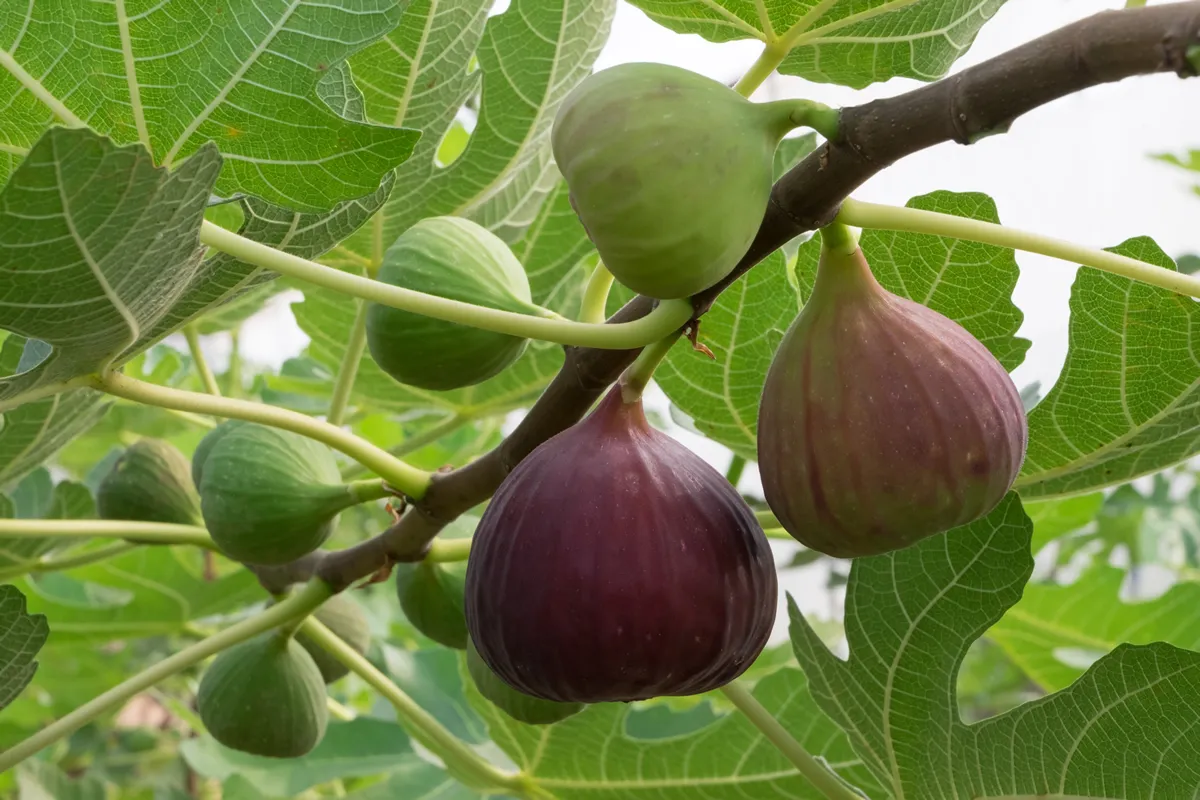 Figs on the branch of a fig tree
Figs on the branch of a fig tree
When it comes to gardening, the success of your plants depends largely on the soil they're grown in. By preparing your soil with compost and other organic matter, you're providing your plants with the essential nutrients they need to thrive. Compost is especially beneficial as it helps with water retention and can improve soil structure. Organic matter such as manure or leaf mould can also be added to enrich the soil. Spending a bit of time preparing your soil before planting can pay dividends in the long run, resulting in luscious, healthy plants. Happy gardening!
When planting fig trees, it's crucial to provide them with the right balance of compost to ensure healthy growth and fruit production. The ideal compost mix for fig trees should offer good drainage, adequate nutrients, and a slightly acidic to neutral pH level (around 6.0 to 6.5). Here's a recommended compost mix for planting fig trees:
- Garden Soil: Start with well-draining garden soil, which will serve as the base for your compost mix. If your native soil is heavy clay or poorly draining, consider amending it with sand or grit to improve drainage.
- Organic Matter: Incorporate a generous amount of well-rotted organic matter, such as garden compost, leaf mold, or well-aged manure, to provide essential nutrients and improve soil structure. Aim for a ratio of 2 parts garden soil to 1 part organic matter.
- Horticultural Grit or Sand: Add horticultural grit or coarse sand to the mix to further improve drainage, especially if your garden soil is heavy or prone to waterlogging. Use about 1 part grit or sand for every 3 parts of soil-organic matter mixture.
- Balanced Fertilizer: Mix in a slow-release, balanced granular fertilizer, such as one with an N-P-K ratio of 10-10-10, at the recommended rate on the product label. This will provide essential nutrients to support the fig tree's growth and fruit production.
- Lime: If your soil is naturally acidic, you may need to add some garden lime to raise the pH level to the desired range. Test your soil pH before adding lime and follow the manufacturer's recommendations for the correct amount to use.
Mix all these components together thoroughly to create a well-balanced compost mix for planting your fig tree. When planting, dig a hole twice as wide and deep as the root ball and fill it with the prepared compost mix. Place the fig tree in the hole, ensuring that the top of the root ball is level with the surrounding soil. Fill in the remaining space with the compost mix, firming it gently around the roots to eliminate air pockets. Water the tree thoroughly after planting and maintain consistent moisture levels, especially during the first year as the tree establishes itself.
Plant your fig tree in a sunny spot with good drainage
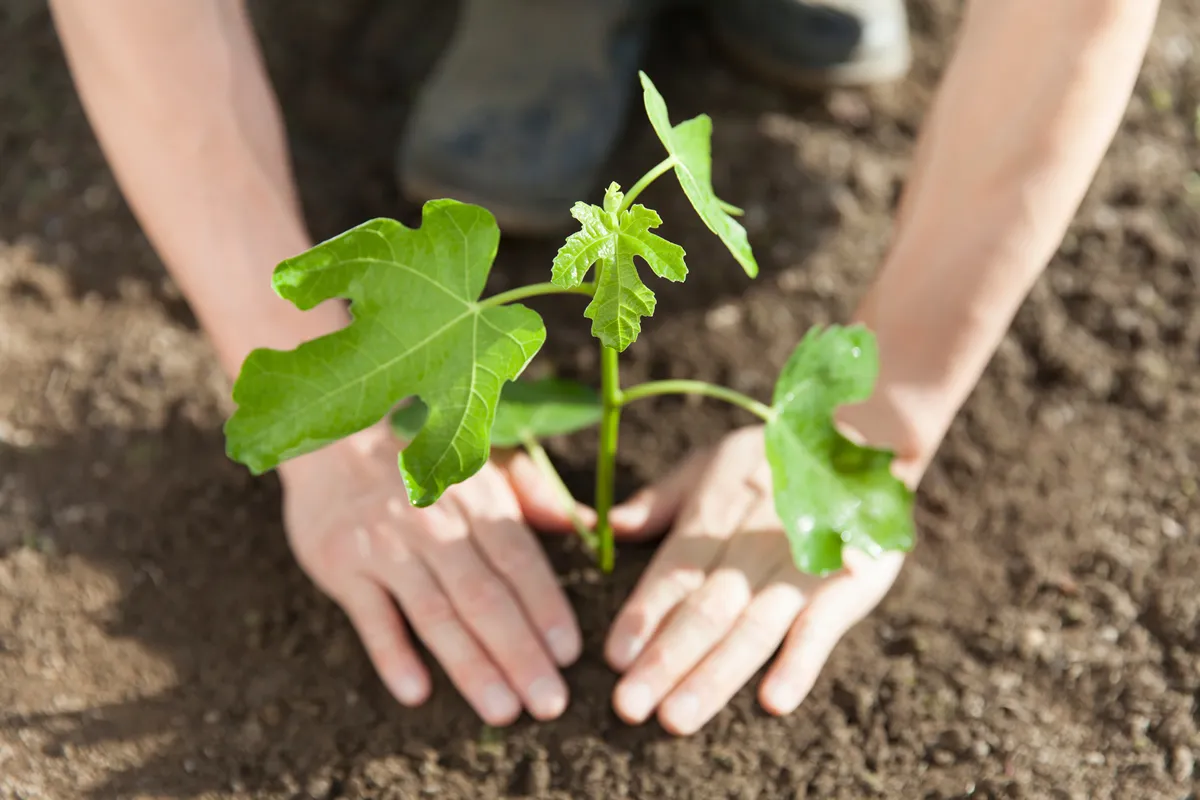 farmer planting fig tree
farmer planting fig tree
If you're ready to plant a fig tree, congratulations! Figs are a delicious and nutritious addition to any garden or yard. One of the most important factors to keep in mind when planting your fig tree is the location. Choose a spot that receives plenty of sun and has good drainage. This will help your fig tree thrive and produce plenty of sweet fruit for you to enjoy. With the right growing conditions and a little bit of care, your fig tree can be a wonderful addition to your outdoor space for years to come.
The best place to plant a fig tree is crucial for its growth, overall health, and fruit production. Here are some key factors to consider when choosing the ideal location for your fig tree:
- Sunlight: Fig trees require plenty of sunlight to grow and produce fruit. Choose a spot that receives at least 6-8 hours of direct sunlight per day, preferably from the south or southwest direction.
- Shelter: Fig trees are sensitive to cold winds and frost, so it's essential to provide them with a sheltered location. Planting your fig tree against a south-facing wall or fence can offer protection from cold winds and help retain heat during the colder months. This is especially important in areas with cooler climates, such as the UK.
- Soil: Fig trees prefer well-draining soil with a slightly acidic to neutral pH level (around 6.0 to 6.5). Avoid planting in heavy clay or waterlogged soil, as this can lead to Root Rot and other issues. If your native soil is not ideal, consider amending it with organic matter, horticultural grit, or sand to improve drainage and fertility.
- Space: Fig trees can grow quite large, so it's important to provide them with enough space to spread their roots and branches. For standard-sized fig trees, allow a spacing of at least 15-20 feet (4.5-6 meters) between trees. If you're planting a dwarf or semi-dwarf variety, they can be spaced closer together, around 10-12 feet (3-3.5 meters) apart.
- Accessibility: Plant your fig tree in a location where you can easily access it for pruning, harvesting, and general maintenance. This will make it easier to care for your tree and enjoy its delicious fruit.
By selecting the best location for your fig tree, considering sunlight exposure, shelter, soil quality, space, and accessibility, you'll create an optimal environment for your tree to thrive and produce an abundant harvest.
How to Plant a Fig Tree in the UK
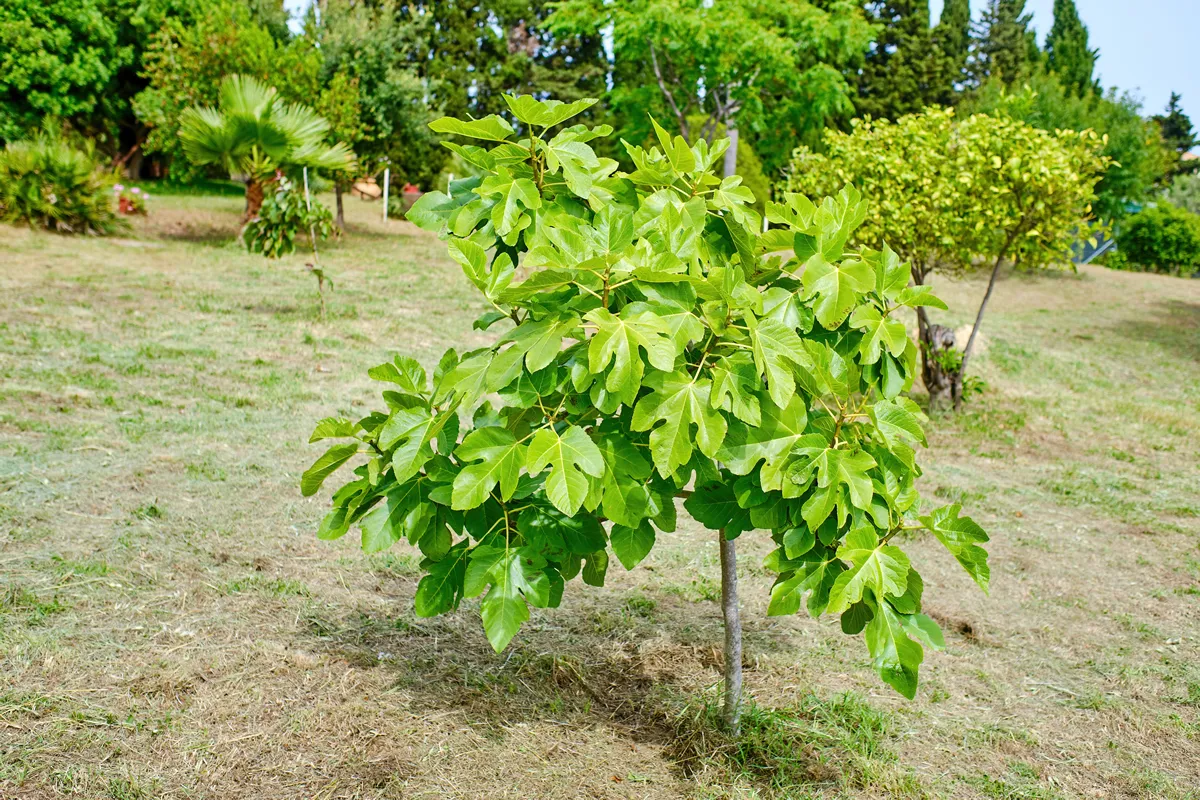 The fig tree. small tree that will soon bear fruit in a garden for own consumption (Ficus carica)
The fig tree. small tree that will soon bear fruit in a garden for own consumption (Ficus carica)
Fig trees are a great addition to any garden, and planting one in the UK can be a fun and rewarding experience. First, choose a sunny spot in your garden where your fig tree can thrive. It's important to ensure the soil is well-drained and rich in nutrients before planting.
Dig a hole that's twice the size of your fig tree's root ball and loosen up the soil at the bottom. Next, place your tree in the hole and backfill with the soil you removed, making sure to lightly pack it around the roots. Water your fig tree well and mulch around the base to help retain moisture. With proper care and attention, your fig tree will provide you with delicious fruits for years to come.
How to Plant a Fig Tree: A Step-by-Step Guide
Follow these steps to plant a fig tree in your garden successfully:
- Step 1: Choose the Right Variety Select a fig tree variety suitable for your climate and garden conditions. Consider factors like hardiness, fruit type, and mature size when making your choice. Some popular fig varieties for cooler climates include 'Brown Turkey', 'Brunswick', and 'White Marseilles'.
- Step 2: Select the Planting Site Choose a planting site that provides at least 6-8 hours of direct sunlight per day, preferably with southern or southwestern exposure. The location should also be sheltered from cold winds and frost, such as near a south-facing wall or fence. Ensure the soil is well-draining and has a slightly acidic to neutral pH level (around 6.0 to 6.5).
- Step 3: Prepare the Soil Prepare the planting area by removing weeds, grass, and debris. If needed, amend the soil with organic matter (compost, leaf mold, or aged manure), horticultural grit or sand, and a balanced slow-release fertilizer. If the soil pH is too low, add garden lime to adjust it to the desired range.
- Step 4: Dig the Planting Hole Dig a hole twice as wide and deep as the fig tree's root ball. This will provide ample space for the roots to spread out and establish themselves. If you're planting against a wall or fence, position the hole about 15-20 inches (38-50 cm) away from the structure for proper air circulation.
- Step 5: Prepare the Fig Tree Remove the fig tree from its container, gently loosening any tangled or circling roots. If the tree is bare-root, soak the roots in water for 1-2 hours before planting to hydrate them.
- Step 6: Plant the Fig Tree Place the fig tree in the planting hole, ensuring that the top of the root ball is level with the surrounding soil. If planting a bare-root tree, spread the roots out evenly in the hole. Fill the hole with the prepared soil, gently firming it around the roots to eliminate air pockets. Ensure that the tree is standing straight and upright.
- Step 7: Water and Mulch Water the fig tree thoroughly after planting, allowing the water to soak deep into the root zone. Apply a 2-3 inch (5-7.5 cm) layer of organic mulch, such as wood chips or bark, around the base of the tree. Keep the mulch a few inches away from the trunk to prevent rot and pest issues.
- Step 8: Stake if Necessary If your fig tree is tall or in a windy location, consider staking it to provide support during its first year of growth. Use a soft tree tie and a sturdy stake, securing the tree loosely to allow for some movement and growth.
- Step 9: Ongoing Care Monitor your fig tree's water needs, especially during the first year, and provide consistent moisture without overwatering. Prune the tree to maintain shape and encourage fruit production, typically during the dormant season (winter). Apply a balanced fertilizer in early spring and again in early summer to support healthy growth and fruiting.
By following these steps, you'll be well on your way to successfully planting and caring for a fig tree in your garden, enjoying its delicious fruit for years to come.
Provide proper watering and nutrients for a healthy fig tree
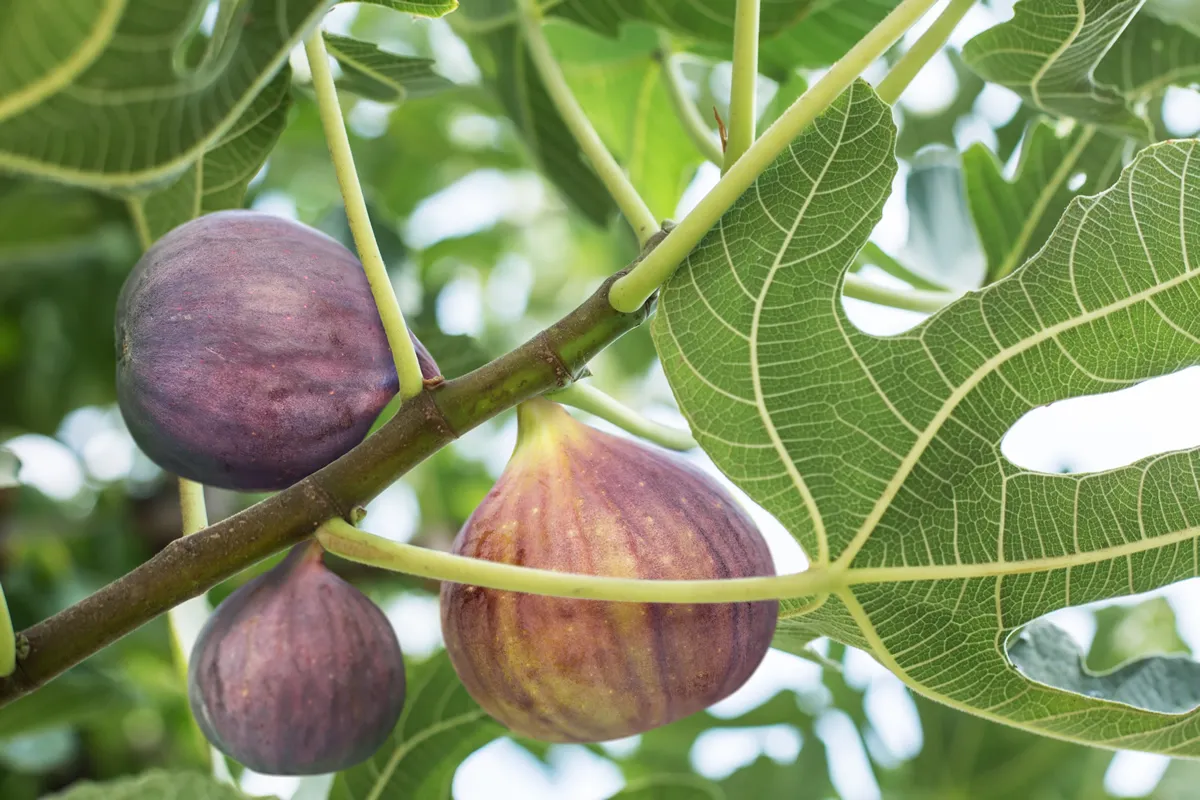 Ripe fig fruits on the tree.
Ripe fig fruits on the tree.
Fig trees are a beautiful addition to any garden, but like any living plant, they need proper care in order to thrive. One of the most important aspects of caring for a fig tree is providing it with adequate water and nutrients. Watering your tree deeply and infrequently, rather than frequently and shallowly, will encourage deeper root growth and prevent the soil from drying out too quickly. Additionally, adding organic matter such as compost or manure to the soil will help provide the tree with the nutrients it needs to grow strong and healthy. By following these simple steps, you can help your fig tree reach its full potential and enjoy delicious, juicy fruit for years to come!
Comprehensive Guide to Watering and Feeding a Specific Type of Fig Tree
Fig trees are a beautiful and fruitful addition to any garden. However, they require proper care and attention to thrive. In this comprehensive guide, we will discuss how to effectively water and feed a specific type of fig tree, the Ficus carica, throughout the year. We will begin by addressing the specific needs of fig trees and potential challenges that may arise. Then, we'll outline a detailed watering schedule and provide expert advice on fertilizing. Finally, we'll offer tips on troubleshooting common problems.Specific Needs of Fig Trees and Potential Challenges
Fig trees are native to the Mediterranean region and are well-suited for warm, dry climates. They are drought-tolerant and can survive in various soil types. However, they prefer well-draining soil with a pH between 6.0 and 6.5. Some potential challenges when growing fig trees include:- Over or under-watering
- Nutrient deficiencies
- Pests such as fig beetles, Aphids, and scale insects
Detailed Watering Schedule
To ensure your fig tree stays properly hydrated, follow this watering schedule:Spring and Summer
During the active growing season, water your fig tree deeply once a week. If you receive at least an inch of rainfall per week, you may not need to water your tree at all. Monitor the soil moisture using a moisture meter or by feeling the soil 2 inches below the surface. If it feels dry, it's time to water.Fall and Winter
As the tree goes dormant in colder months, reduce the frequency of watering to once every two to three weeks. Always check the soil moisture before watering, as over-watering during dormancy can lead to Root Rot.Fertilizing Your Fig Tree
Fig trees typically don't require much fertilization, but providing additional nutrients can help promote healthy growth and fruit production. Here are some best practices for fertilizing:- Type of fertilizer: Use a balanced, slow-release granular fertilizer with an N-P-K ratio of 10-10-10 or 14-14-14.
- When to apply: Apply fertilizer in early spring, just before the first flush of new growth. You can also apply a second application in mid-summer if your tree is showing signs of nutrient deficiency.
- How much to use: Follow the package instructions for the specific fertilizer you're using. Generally, it's recommended to use 1 pound of fertilizer per inch of trunk diameter, measured at chest height.
- Application method: Spread the fertilizer evenly around the base of the tree, extending out to the drip line. Avoid placing fertilizer directly against the trunk, as this can cause damage. After applying, water the area thoroughly to help the fertilizer penetrate the soil.
Troubleshooting Common Problems
Over or Under-Watering
Symptoms of over-watering include yellowing leaves, soft or mushy fruit, and Root Rot. To correct this issue, reduce the frequency of watering and ensure your soil has proper drainage.
Under-watered fig trees may have wilting leaves, premature fruit drop, and stunted growth. Increase your watering frequency and consider adding organic mulch around the base of the tree to help retain moisture.
Nutrient Deficiencies
Pale, yellowing leaves can indicate nutrient deficiencies, particularly nitrogen. Apply a balanced fertilizer as recommended above to address this issue.Pests
Monitor your fig tree regularly for signs of pests such as fig beetles, Aphids, and scale insects. If you notice an infestation, treat your tree with an appropriate insecticide or introduce beneficial insects like ladybugs to help control the problem.
By following this comprehensive guide, even novice gardeners can successfully care for their fig tree and enjoy a bountiful harvest. Remember to monitor your tree's health regularly and adjust your watering and fertilizing practices as needed. Happy gardening!
Prune the tree to promote fruiting and growth
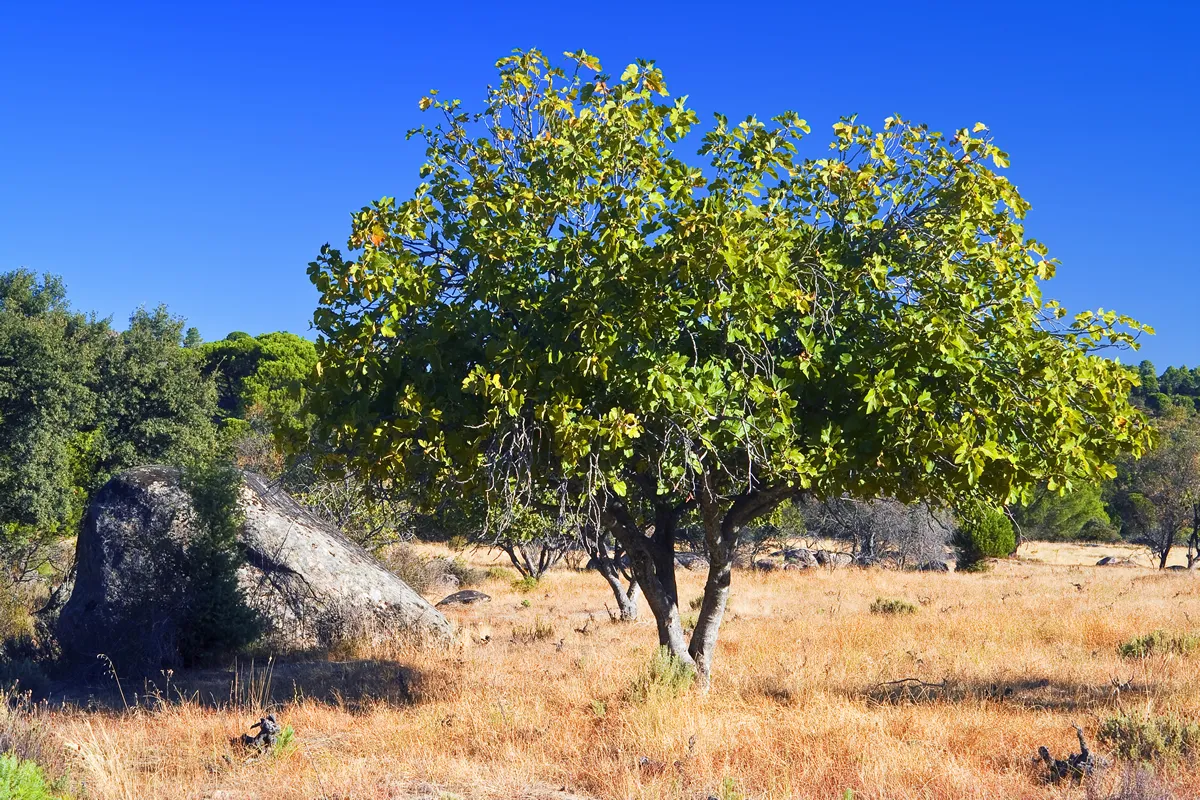 Fig tree in Cadalso de los Vidrios. Madrid. Spain. Europe.
Fig tree in Cadalso de los Vidrios. Madrid. Spain. Europe.
Pruning may seem like a daunting task, but it can work wonders for your fruit tree's growth and productivity. By selectively cutting away dead or excess branches, you're improving the tree's overall health and allowing more sunlight and air to flow through its leaves. This not only encourages the tree to produce more fruit, but also helps it grow stronger and more resilient over time. It's important to prune at the right time of year and to use proper techniques, but with a little bit of research and effort, you can transform your lackluster fruit tree into a thriving, fruitful addition to your garden.
Protect the tree from frost or extreme temperatures
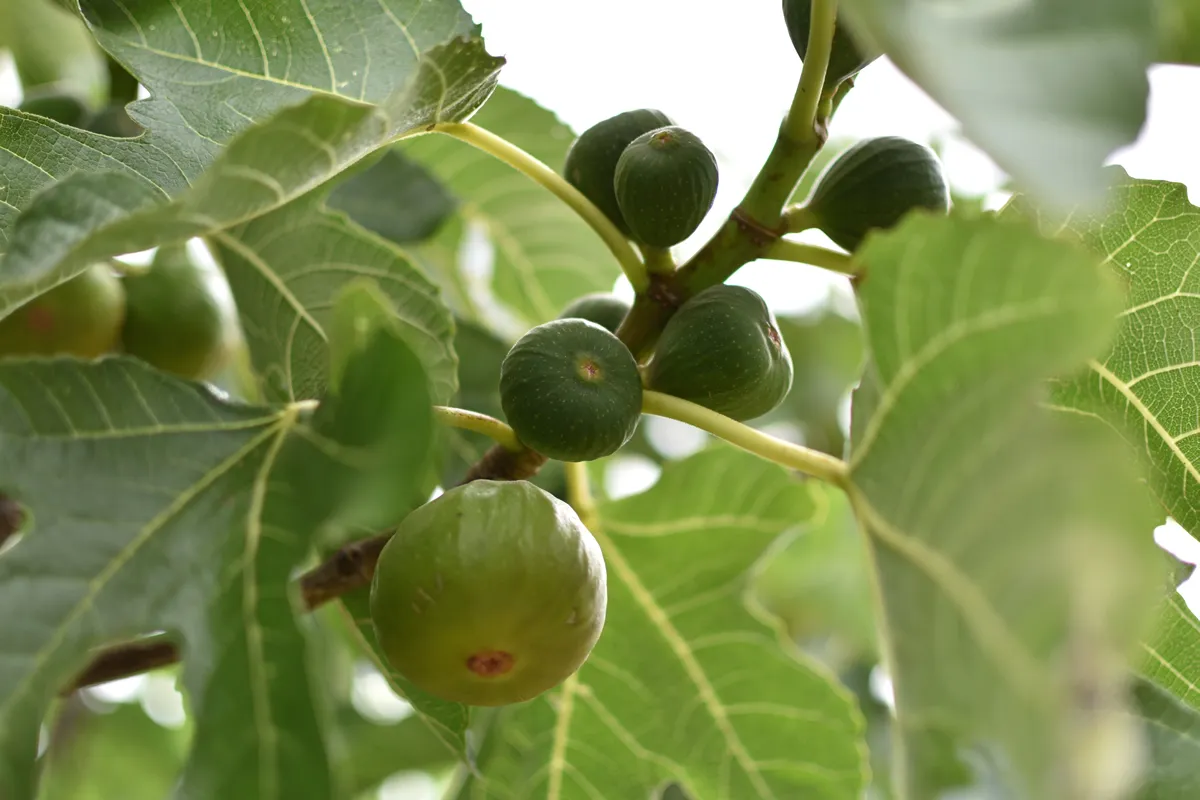 Green figs fruit hanging on the branch of a fig tree, ficus carica
Green figs fruit hanging on the branch of a fig tree, ficus carica
As the temperature begins to drop and frost starts to form, it's important to protect your trees from any potential damage. A frost can be disastrous for trees, causing leaves to fall off prematurely and weakening the trees' overall structure. One way to protect them is to wrap the trunks with insulating materials, such as blankets or burlap sacks. Additionally, you can cover the entire tree with a frost cloth to create a barrier against the extreme chill. Taking these precautions can increase the chances of your trees successfully surviving the harsh winter months.
Preparing a Fig Tree for Winter
Fig trees, being native to warmer climates, can be sensitive to colder temperatures and harsh winter conditions. However, with proper preparation, your fig tree can survive the winter and thrive in the following growing season. Here's a step-by-step guide on how to prepare your fig tree for winter:-
Step 1: Monitor the Weather
Start monitoring the weather as autumn progresses. Once the temperature starts consistently falling below 20°F (-6°C), it's time to begin preparing your fig tree for winter. -
Step 2: Stop Fertilizing
Stop fertilizing your fig tree by late summer or early autumn. This will help the tree to harden off and prepare for dormancy. Fertilizer encourages new growth, which is more susceptible to freeze damage. -
Step 3: Water the Tree
Water the tree thoroughly before the first frost. Hydrated trees are better equipped to handle freezing temperatures. However, avoid over-watering as soggy soil can lead to Root Rot. -
Step 4: Protect the Roots
Apply a thick layer (about 4-6 inches) of organic mulch around the base of the tree, extending it out to the drip line. Mulch will insulate the roots from freezing temperatures and help retain soil moisture. -
Step 5: Wrap the Tree
If you live in a region with severe winters, consider wrapping your fig tree. Start by tying the branches together with twine, starting from the bottom and working your way up. Then, wrap the tree with burlap or a specially designed tree blanket. Secure the wrapping with additional twine. -
Step 6: Install a Protective Structure
For added protection, you can build a protective structure around the tree. A simple way to do this is to drive four stakes into the ground around the tree, then wrap burlap or heavy-duty plastic around the stakes to create a windbreak. Fill the inside with straw or leaves for additional insulation. -
Step 7: Monitor and Maintain
Throughout the winter, check the tree regularly to ensure the protective measures are still in place. After the last frost in spring, remove the protective materials to allow the tree to exit dormancy.
By following these steps, you can help ensure your fig tree survives the winter and is ready to produce a healthy crop in the coming year. Preparation is key when it comes to winterizing fig trees, so start these steps as soon as the colder weather sets in. Happy gardening!
The Best Propagation methods for the Fig Tree
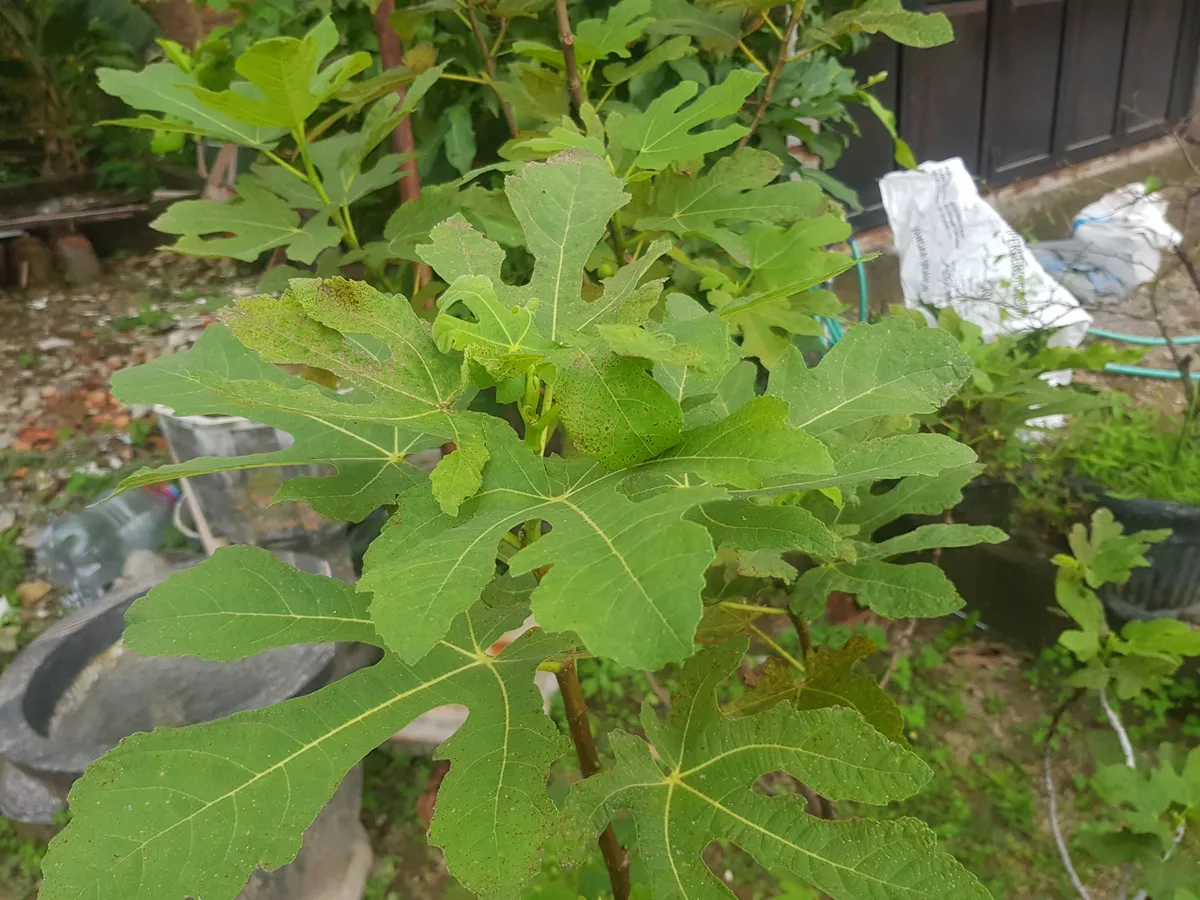 The fig tree. The fig is the edible fruit of Ficus carica, a species of small tree in the flowering plant family Moraceae, native to the Mediterranean region, together with western and southern Asia.
The fig tree. The fig is the edible fruit of Ficus carica, a species of small tree in the flowering plant family Moraceae, native to the Mediterranean region, together with western and southern Asia.
Growing a fig tree can be a challenging yet rewarding experience. If you're looking for the best propagation methods for this fruit-bearing tree, there are a few techniques that stand out. One popular method is through cuttings, which involves taking a section of a healthy branch and planting it in fertile soil. Air layering is another effective option, where you make a small incision in the stem and encourage it to develop roots while still attached to the tree. Whichever method you choose, patience is key – it may take some time for your fig tree to grow and mature, but in the end, the sweet taste of fresh figs will make it all worth it.
Propagating a Fig Tree Using the Cutting Method: A Step-by-Step Guide
Propagating a fig tree from cuttings is a cost-effective way to increase your collection of this fruit-bearing plant. Here's a step-by-step guide on how to do it:-
Step 1: Gather Your Supplies
Before you begin, make sure you have all the necessary supplies:
- Pruning shears or a sharp knife
- A healthy fig tree (for taking cuttings)
- Rooting hormone (optional but recommended)
- A small pot (4-6 inches in diameter)
- Well-draining potting mix
- Clear plastic bag or a plastic dome
- Step 2: Take a Cutting Choose a healthy branch from your fig tree that's about 1/4 to 1/2 inch in diameter. The best time to take cuttings is in late winter or early spring when the tree is dormant. Make a clean cut about 8-10 inches from the tip of the branch. The cutting should include 3-5 nodes (the bumps where leaves attach).
- Step 3: Prepare the Cutting Remove the leaves from the lower half of the cutting. If you wish, you can lightly scrape the bark near the base of the cutting to expose the cambium layer, which can encourage rooting.
- Step 4: Apply Rooting Hormone Dip the cut end of the stem into a rooting hormone. This step is optional, but it can significantly improve the success rate of propagation. Shake off any excess hormone.
- Step 5: Plant the Cutting Fill your pot with well-draining potting mix. Make a hole in the center of the soil with your finger or a pencil. Insert the cutting into the hole, ensuring the nodes are buried in the soil. Firmly press the soil around the cutting to provide support.
- Step 6: Create a Mini Greenhouse Place the pot in a clear plastic bag or cover it with a plastic dome to create a mini greenhouse. This helps maintain humidity around the cutting, which encourages root development.
- Step 7: Place in a Suitable Location Place the pot in a warm location with indirect light. Avoid direct sunlight as it can overheat the cutting and dry out the soil.
- Step 8: Monitor and Care for the Cutting Check the soil moisture regularly. It should remain evenly moist but not waterlogged. In 4-8 weeks, the cutting should develop roots. You can check by gently tugging on the cutting; if there's resistance, roots have formed.
- Step 9: Transplant the New Fig Tree Once a healthy root system has developed, and new growth appears, you can transplant your new fig tree into a larger pot or directly into the ground, depending on your climate and the time of year.
With patience and care, you can successfully propagate a fig tree using the cutting method. Now, you're on your way to expanding your fig tree collection! Happy gardening!
Growing a Fig Tree from Seed: A Step-by-Step Guide
Growing a fig tree from seed can be a rewarding experience, but it requires patience as this process takes longer than propagation methods like cuttings or layering. Here's a step-by-step guide on how to grow a fig tree from seed:-
Step 1: Gather Your Supplies
Before you begin, make sure you have all the necessary supplies:
- Fresh fig fruit
- Knife
- Container
- Well-draining potting mix
- Clear plastic bag or a plastic dome
- Step 2: Extract Seeds Cut open a ripe fig fruit and scrape out the seeds. Rinse them under warm water to remove any pulp, then let them dry on a paper towel.
- Step 3: Prepare the Seed Tray Fill your container with a well-draining potting mix. The depth of the container should be at least 3 inches to allow for root growth.
- Step 4: Sow the Seeds Sprinkle the fig seeds over the surface of the soil. Then, lightly cover them with a thin layer of potting mix.
- Step 5: Water the Seeds Water the potting mix thoroughly but gently to avoid washing away the seeds. The soil should be damp but not waterlogged.
- Step 6: Create a Mini Greenhouse Cover the container with a clear plastic bag or a plastic dome. This helps maintain humidity around the seeds, which encourages germination.
- Step 7: Place in a Suitable Location Place the container in a warm location with indirect sunlight. The ideal temperature for fig seed germination is between 70°F and 85°F (21°C - 29°C).
- Step 8: Monitor the Seeds Check the soil moisture regularly. It should remain evenly moist but not waterlogged. In 2-4 weeks, you should see the first seedlings appear.
- Step 9: Transplant the Seedlings Once your seedlings have developed their first set of true leaves, they're ready to be transplanted into individual pots. Be gentle during this process to avoid damaging the young roots.
- Step 10: Care for Your Fig Tree Continue to care for your young fig tree by providing regular water, plenty of indirect sunlight, and occasional fertilization with a balanced plant food.
Remember, growing fig trees from seed is a long-term project, but the reward of watching a tree you've grown yourself from a tiny seed is worth the wait. Happy gardening!
When is the Best Time to Harvest a Fig Tree
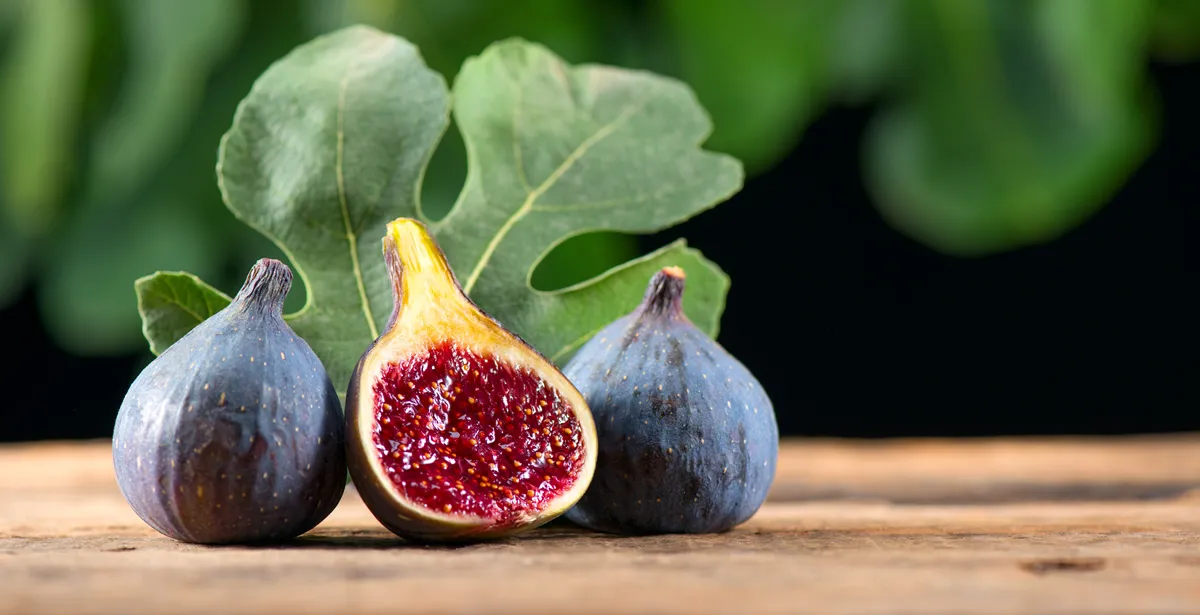 Ripe fig fruits with leaf close-up. Beautiful sweet fresh organic figs on a wooden table. Label design. Healthy vegan food
Ripe fig fruits with leaf close-up. Beautiful sweet fresh organic figs on a wooden table. Label design. Healthy vegan food
Fig trees are known for their sweet and juicy fruits. However, harvesting these fruits can be a bit tricky. As a fig tree owner, one must keep an eye on the tree and the fruits it bears. The best time to harvest a fig tree would be when the skin of the fruit starts to stretch, the fruit softens, and the colour changes from green to a light brown or violet hue. This indicates that the fig is ripe and ready to eat. Harvesting at this stage ensures that the figs are sweet and succulent, making them a delight to eat. Timing is key when it comes to harvesting figs. So, it's important to keep an eye on your tree and know the signs of when the figs are ready to be picked.
Fig trees typically produce two crops a year. The first, or "breba" crop, develops in the spring on last year's shoot growth and ripens in late spring or early summer. The second, or "main" crop, develops on the current year's shoot growth and ripens in late summer to early fall.
Therefore, depending on your location and the specific variety of fig tree, harvest time for figs can range from June through September. Always remember that figs do not continue to ripen after they are picked, so it's important to harvest them when they are fully ripe, usually when the fruit is drooping and changes colour.
The Pests and Diseases which affect the Fig Tree in the UK
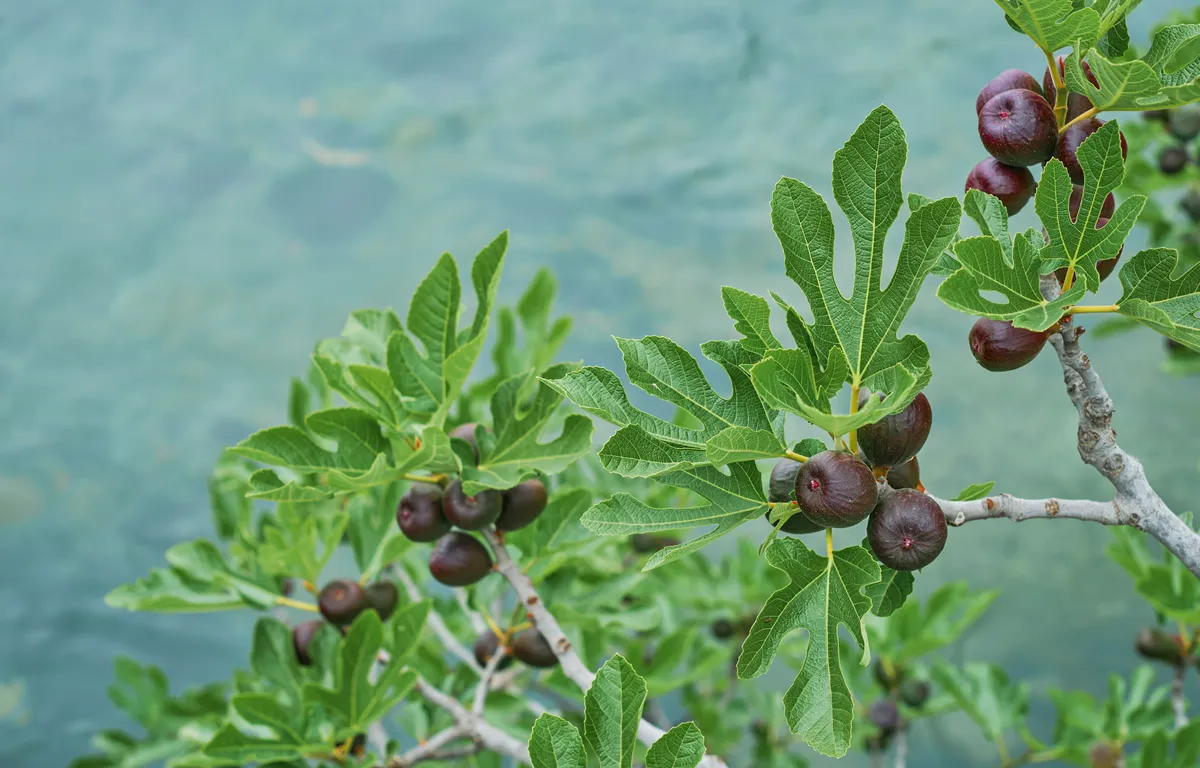 fig tree with ripening figs, selective focus for fruit. Fig grows over a mountain stream, sustainable agriculture and environmental care
fig tree with ripening figs, selective focus for fruit. Fig grows over a mountain stream, sustainable agriculture and environmental care
Fig trees are known for their sweet and succulent fruits that are enjoyed by many. However, they can fall victim to various pests and diseases that can cause significant damage to the tree and its yield. In the UK, some of the more common pests that affect fig trees include Spider Mites, scale insects, and mealybugs. These critters can cause the leaves to yellow and eventually fall off. Other diseases that can harm fruit production include fig mosaic virus and fig rust. It is essential to keep an eye out for these potential threats and take necessary precautions to protect the tree and its harvest. With proper care, fig trees can thrive and continue to produce delicious fruit for years to come.
Pests and Diseases Affecting Fig Trees in the UK
Fig trees in the UK are generally quite hardy, but they can still be affected by certain pests and diseases. Here's a list of some common issues:-
1. Fig Rust (Cerotelium fici)
- Symptoms: Fig rust is a fungal disease that causes the leaves of the fig tree to turn yellow-brown and drop prematurely.
- Remedy: If your fig tree is affected by fig rust, remove and destroy all fallen leaves to prevent the spread of the fungus. Fungicide sprays can also be used to control the disease.
- Prevention: Regularly inspect your fig tree for signs of disease, and maintain good air circulation around the tree by proper pruning and spacing.
-
2. Stem Borers
- Symptoms: Stem borers are insects that bore into the wood of the fig tree, causing wilting and death of branches.
- Remedy: Infested branches should be pruned and destroyed. In severe cases, insecticide may be necessary.
- Prevention: Regular inspection of your fig tree can help catch an infestation early before it causes significant damage.
-
3. Aphids
- Symptoms: Aphids are small insects that suck sap from the fig tree, causing distorted and yellowed leaves, stunted growth, and a sticky substance on the leaves or underneath the tree.
- Remedy: Aphids can often be controlled with a strong spray of water from a hose. Insecticidal soap or neem oil can also be effective.
- Prevention: Encourage beneficial insects like ladybugs and Lacewings that prey on Aphids. Avoid over-fertilizing your fig tree, as this can encourage aphid populations.
-
4. Root Knot Nematodes
- Symptoms: Root knot nematodes are microscopic worms that cause galls or knots on the roots of the fig tree, leading to yellowed, wilted leaves, stunted growth, and reduced fruit production.
- Remedy: There are no effective chemical treatments for root knot nematodes available to home gardeners. Affected trees should be removed and destroyed.
- Prevention: Plant resistant varieties if available, and practice good sanitation by cleaning tools and not sharing soil between plants.
By keeping an eye out for these common pests and diseases, you can ensure your fig tree stays healthy and productive. Remember, prevention is often the best cure, so maintain good cultural practices and regularly inspect your tree.
Common Mistakes made with the Fig Tree
 Sacred Fig Tree, Pipal Tree, Bohhi Tree, Bo Tree, Peepul, Heart Shape Green Bodhi Leaf Background. is budding at the beginning of the rainy season
Sacred Fig Tree, Pipal Tree, Bohhi Tree, Bo Tree, Peepul, Heart Shape Green Bodhi Leaf Background. is budding at the beginning of the rainy season
Fig trees are a true gift from nature. Their luscious fruit can be used in various recipes, and their waxy leaves add a touch of elegance to any garden. However, caring for a fig tree can be quite challenging, especially if you are unaware of the common mistakes that can happen during the process. One of the most frequent errors is overwatering or underwatering the tree. This can lead to the death of the plant or the development of Root Rot. Another mistake is not pruning the tree regularly, which can result in an unhealthy, overgrown shrub with low fruit yield. However, with proper care and knowledge, your fig tree can thrive and provide you with the delicious fruit you deserve.
Common Mistakes with Fig Trees and How to Prevent Them
Fig trees are relatively easy to care for, but there are still common mistakes that gardeners can make. Here's a guide on how to spot and prevent them:
-
1. Planting in Poorly Draining Soil
Mistake: Fig trees dislike waterlogged soil, which can lead to Root Rot.
Prevention: Always plant your fig tree in well-draining soil. If your soil is heavy clay, consider planting the fig tree in a raised bed or container to improve drainage.
-
2. Overwatering or Underwatering
Mistake: Both overwatering and underwatering can harm your fig tree. Overwatering can lead to Root Rot, while underwatering can stress the tree and reduce fruit production.
Prevention: Water your fig tree deeply and infrequently, allowing the top inch of soil to dry out between waterings. Adjust your watering schedule based on weather conditions and the age of the tree.
-
3. Over-fertilizing
Mistake: Over-fertilizing can lead to excessive leaf growth at the expense of fruit production. It can also make the tree more susceptible to disease and pest problems.
Prevention: Figs generally require little fertilization. Only fertilize if your tree shows signs of nutrient deficiency, such as yellowing leaves. Use a balanced, slow-release fertilizer and always follow package instructions.
-
4. Incorrect Pruning
Mistake: Incorrect pruning can reduce fruit production and make the tree more susceptible to disease.
Prevention: Prune your fig tree in late winter or early spring when it's still dormant. Remove any dead or diseased wood, and prune to open up the center of the tree for better air circulation. Avoid heavy pruning as it can stress the tree and reduce fruit production.
-
5. Ignoring Pests and Diseases
Mistake: Ignoring signs of pests and diseases can lead to significant damage and even loss of the tree.
Prevention: Regularly inspect your fig tree for signs of pests and diseases. If you notice anything unusual, such as discolored leaves or stunted growth, identify the problem and treat it promptly.
By avoiding these common mistakes, you can ensure your fig tree stays healthy and productive. Remember, the key to successful fig tree care is understanding the needs of the tree and adjusting your care practices accordingly.
Growing a Fig Tree in a Pot or Container in the UK
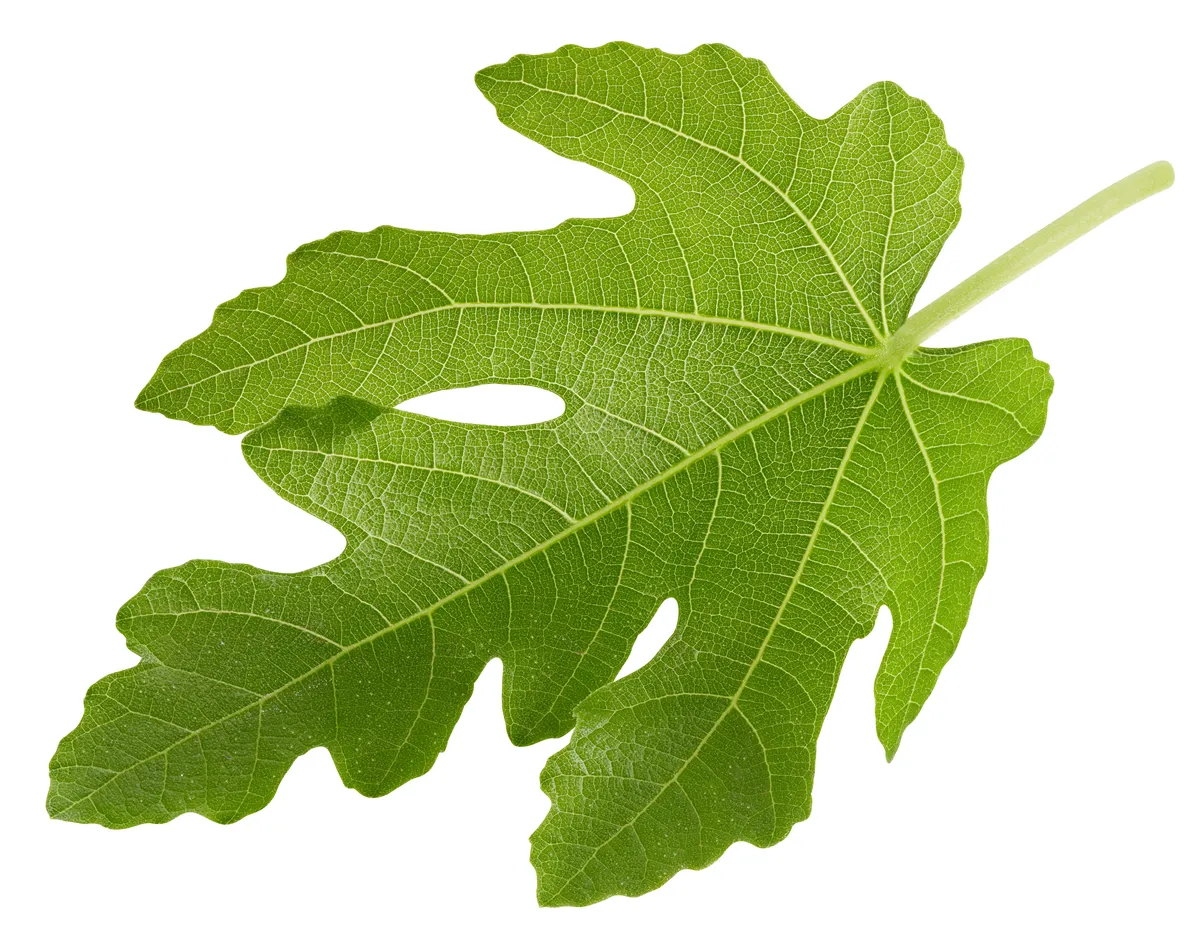 Fig leaf isolated clipping path. Fig leaf on white background.
Fig leaf isolated clipping path. Fig leaf on white background.
Growing a fig tree in a pot or container in the UK might sound like an impossible feat, but with the right care and attention, it can be a rewarding experience. With a little bit of planning and patience, you can enjoy the sweet and succulent taste of figs right from the comfort of your own home. Fig trees thrive in warm and sunny climates, so make sure to place your container in a spot that receives ample sunlight throughout the day. It's also important to water your fig tree regularly and keep an eye out for any pests or diseases that may harm it. With these tips and tricks, you can successfully grow a fig tree in your own backyard and enjoy the delicious fruit it produces.
A Comprehensive Guide to Planting and Growing a Fig Tree in a Pot or Container in the UK
Growing a fig tree in a pot or container can be a rewarding endeavour, especially for those with limited garden space. Here's a comprehensive guide on how to do it:
Required MaterialsBefore you begin, gather the following materials:
- A large pot or container with drainage holes (at least 45 cm in diameter)
- Well-draining potting mix
- Slow-release granular fertilizer
- A fig tree sapling
- Mulch (optional)
- Pruning shears
Choose a pot that's at least 45 cm in diameter to give the fig tree plenty of room to grow. Make sure the pot has several drainage holes to prevent waterlogging.
Fill the pot with a well-draining potting mix. You can create your own mix by combining one part compost, one part perlite or coarse sand, and one part peat moss.
Add a slow-release granular fertilizer to the potting mix according to the package instructions. This will provide the nutrients your fig tree needs to grow.
Choosing and Planting the Fig Tree Sapling- Choose a healthy fig tree sapling from a reputable nursery. Look for a sapling with bright, vibrant leaves and no signs of pests or diseases.
- Dig a hole in the center of the pot that's deep enough to accommodate the root ball of the sapling. The top of the root ball should be level with or slightly below the surface of the soil.
- Place the sapling in the hole and gently backfill with the potting mix. Firm the soil around the base of the sapling to provide support.
- Water thoroughly after planting. The soil should be damp but not waterlogged.
- Watering: Water your fig tree deeply and infrequently, allowing the top inch of soil to dry out between waterings. Adjust your watering schedule based on weather conditions.
- Fertilization: Figs generally require little fertilization. Only fertilize if your tree shows signs of nutrient deficiency, such as yellowing leaves. Use a balanced, slow-release fertilizer and always follow package instructions.
- Pruning: Prune your fig tree in late winter or early spring when it's still dormant. Remove any dead or diseased wood, and prune to shape the tree and encourage bushier growth.
- Pest Management: Regularly inspect your fig tree for signs of pests and diseases. If you notice anything unusual, identify the problem and treat it promptly.
- Location: Fig trees need a sunny, sheltered spot to grow. A south or west-facing wall is ideal.
- Mulching: Apply a layer of mulch around the base of the tree to help retain soil moisture and suppress weeds.
- Winter Protection: In colder regions, move the pot to a sheltered location or wrap it with bubble wrap to protect the roots from freezing temperatures.
- Re-potting: As your fig tree grows, it may become root-bound. If this happens, re-pot the tree into a larger container.
In conclusion, we have discussed the fig tree and how to plant it in UK's climate. From an overview of the fig tree and its history in UK to preparing soil for the fruiting tree, there is enough knowledge to understand why this tree holds such a special place in British culture. To ensure a healthy fig tree, providing appropriate levels of water and nutrients is key. Because fig trees are sensitive to frost and extreme temperatures, protecting them must be part of any growing regimen. With regards to propagating new trees, cuttings or air layering are recommended options for the amateur gardener. Harvesting these sweet fruits can usually begin four years after planting your fig tree. While there may be some possible issues with pests and diseases, practicing proper garden hygiene should prevent any major outbreaks from occurring in the first place. Lastly, even if space is limited outside, a fig tree can also make a great addition to a larger container or pot - adding an interesting touch to any patio or balcony!
A Complete Guide to Pruning a Fig Tree in the UK
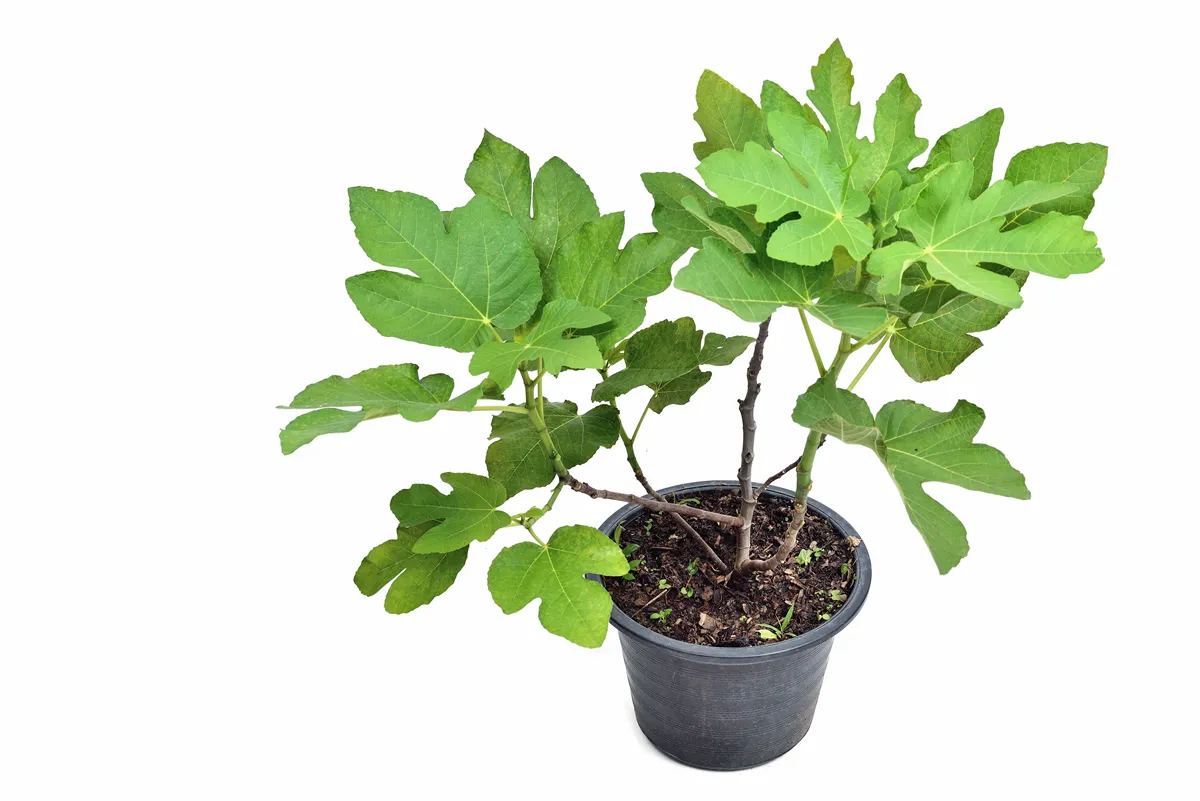 Ficus carica (Alma) tree, Fig tree in black plastic pot
Ficus carica (Alma) tree, Fig tree in black plastic pot
Are you a proud UK gardener looking to jumpstart your fruit-growing journey with the legendary fig tree? An alluring and iconic symbol of nature's bounty, the edible fig has been revered since ancient times as an embodiment of abundance and prosperity. But despite its illustrious roots, some gardeners have difficulty growing this treasured plant due to pruning demands that vary by climate and geography. Never fear - we at Garden Hub are here to provide you with a complete guide on nurturing and harvesting beautiful figs from your own backyard! From fundamental concepts like when exactly to prune a UK fig tree to variety-specific instructions tailored towards the British microclimates, our step-by-step guide will help you make sure your efforts yield delectable plump fruits for years to come!
Understand the basics of pruning a fig tree in the UK
 The fig tree. The fig is the edible fruit of Ficus carica, a species of small tree in the flowering plant family Moraceae, native to the Mediterranean region, together with western and southern Asia.
The fig tree. The fig is the edible fruit of Ficus carica, a species of small tree in the flowering plant family Moraceae, native to the Mediterranean region, together with western and southern Asia.
Pruning a fig tree might sound intimidating, but it's an essential task to ensure healthy growth and abundant fruit production. The key is understanding the basics of when and how to prune your fig tree. If you're based in the UK, timing is a crucial factor as fig trees are frost sensitive and pruning at the wrong time can result in damage or even death of the tree. Typically, pruning should occur in the late winter or early spring before new growth starts. When it comes to the actual pruning technique, it's important to remember that less is often more with fig trees. Focusing on removing any damaged or diseased branches and thinning out the canopy can help create a more conducive environment for fruit production. By following these basic guidelines, you can help your fig tree thrive and continue to produce delicious figs.
A Comprehensive Guide to Pruning a Fig Tree for Beginner Gardeners in the UK
Pruning is an essential part of maintaining the health and productivity of a fig tree. This comprehensive guide will help beginners understand how and when to prune their fig tree.
The Importance of Pruning
Pruning helps maintain the shape of your fig tree, encouraging it to grow bushier and produce more fruit. It also removes dead or diseased wood, which can be a drain on the tree's resources and a potential source of infection. In the UK, the best time to prune a fig tree is in late winter or early spring when the tree is still dormant.
Tools Required for Pruning
Here are the tools you'll need:
- Pruning Shears: For most of the smaller branches.
- Lopping Shears: For larger branches.
- Pruning Saw: For the thickest branches.
- Gardening Gloves: To protect your hands.
- Safety Glasses: To protect your eyes from falling debris.
Always ensure your tools are sharp and clean before you begin to prevent damage to the tree and the spread of diseases.
Pruning Techniques
Here's how to prune your fig tree:
1. Remove DeadwoodStart by removing any dead or diseased branches. These will feel dry and brittle and may have visible signs of disease like discolouration or fungus. Cut these branches back to healthy wood.
2. Remove Water GrowthNext, remove any water shoots – these are thin, straight branches that shoot straight up and don't produce fruit. They drain resources from the rest of the tree.
3. Thin Out Excess FoliageThin out areas of the tree that are overly dense with leaves to improve air circulation and sunlight penetration. This can help prevent diseases and improve fruit production.
4. Prune Low Hanging BranchesPrune any branches that hang too low or touch the ground. These can be a pathway for pests and diseases.
When making cuts, always cut just above a bud or branch. Make the cut at a slight angle to allow water to run off and not sit on the cut, which could cause rot.
After-Care Steps
After pruning, give the tree a thorough watering and apply a balanced, slow-release fertilizer to help it recover. Keep an eye on the pruned areas for any signs of disease or pest activity.
Extra Tips
- Less is More: Over-pruning can stress the tree and reduce fruit production. As a rule of thumb, never remove more than a third of the tree's branches in one go.
- Disinfect Your Tools: Always disinfect your tools before and after pruning to prevent the spread of diseases.
- Take Care of Wounds: Larger cuts can be painted with a tree wound dressing to prevent infection.
By following these steps, even beginner gardeners can successfully prune their fig trees, leading to healthier trees and better fruit production. Happy gardening!
Determine when to prune your tree for best results
 Figs on the branch of a fig tree
Figs on the branch of a fig tree
Trees are an essential part of any landscape, and they require proper care and maintenance to grow strong and healthy. Pruning is a crucial aspect of tree care, but it can be confusing to determine when the best time to do it is. Generally, it's best to prune your tree during the dormant season or winter when the tree is not actively growing. This allows for the tree to heal faster and limit any damage that pruning may cause. However, there are exceptions to this rule, such as if a tree is damaged or diseased, in which case it's best to prune it immediately. Understanding when to prune your tree can have a significant impact on its overall health and growth, so be sure to consult with a professional if you have any doubts or concerns.
Learn about essential tools and supplies for pruning
 tin or figs trees affected by leaf rust disease
tin or figs trees affected by leaf rust disease
Pruning is an essential practice that helps maintain the health and beauty of plants. To ensure your pruning efforts are successful, you need to have the right tools and supplies. A good pruning saw, hand pruners, and loppers are among the essential tools required. In addition to that, it's crucial to have protective gear such as gloves and safety glasses to prevent injuries. To make the pruning process more manageable, you can also invest in tools such as pole pruners, which help you reach higher branches without a ladder. By having the right tools and supplies, you can ensure that your pruning efforts are safe, efficient, and successful.
Identify the correct way to cut back branches
 Ripe fig fruits on the tree
Ripe fig fruits on the tree
Maintaining your trees and shrubs is crucial to their overall health and beauty. If you need to cut back branches, it's important to do so the right way. One essential tip is to avoid making a clean cut right up against the trunk or main branch. Instead, angle your cut slightly away from the trunk to prevent water from pooling and causing rot. Additionally, be sure to use proper pruning tools and avoid leaving any jagged or torn edges. With these simple guidelines, you can help your plants thrive and look their best. Happy pruning!
When pruning, it's important to angle your cut slightly away from the trunk for a few reasons:
- Promote Healing: An angled cut allows water to run off the cut surface, rather than pooling on it. This reduces the likelihood of the cut area staying wet and becoming susceptible to diseases or rot.
- Prevent Damage to Buds: By cutting at an angle, you're less likely to damage the bud that's usually located at the base of the branch. This bud is crucial as it will produce new growth once the branch has been removed.
- Avoid Damaging the Trunk: Angling the cut away from the trunk also helps ensure that the remaining stub does not die back into the trunk, which could cause further damage or disease.
Therefore, always remember to make your pruning cut at a slight angle to promote healthy regrowth and protect the overall health of your tree.
Learn how to thin out the canopy of your tree
 Fig tree in Cadalso de los Vidrios. Madrid. Spain. Europe.
Fig tree in Cadalso de los Vidrios. Madrid. Spain. Europe.
If you have noticed that your tree's canopy is becoming too thick and dense, it might be time to thin it out a bit. Thinning the canopy not only makes the tree look better but also improves its overall health by allowing more sunlight and airflow to penetrate the branches. It's important to thin the canopy properly, though, so that you don't accidentally damage the tree. By learning how to thin out a tree canopy, you can give your tree the care it needs to thrive and grow for years to come. With a bit of patience and precision, you can turn your overgrown tree into a beautiful, healthy addition to your garden or landscape.
Discover the importance of protective clothing and eye protection
 Green figs fruit hanging on the branch of a fig tree, ficus carica
Green figs fruit hanging on the branch of a fig tree, ficus carica
Protective clothing and eye protection are critical measures to ensure personal safety in numerous work environments. The use of proper protective gear is not only necessary, but it is also mandatory in some professions. For instance, firefighters are required to wear helmets, gloves, and boots to protect themselves from falling debris and flames. Similarly, individuals working in the construction industry require protective gear to prevent injuries from falling objects, dust, and hazardous materials. At times, the smallest of sparks can have significant consequences. Wearing protective clothing and eyewear is undoubtedly essential, as it can save a person's life or prevent severe injuries. It is crucial to understand and abide by the safety regulations in your field of work, and investing in top-quality protective gear should be a priority.
Pruning a fig tree can be a rewarding experience that not only yields the desirable results of a lush, healthy fig tree but also allows you to enjoy the calming effects of gardening. Ultimately, with the right knowledge and understanding on how to prune your tree, you have the power to make sure it remains strong and vibrant throughout its life span. Keeping in mind the essential items needed for pruning, such as protective gloves and eyewear, as well as which branches should be cut back and thinned out are pointers that will help guide you in achieving that lush canopy of leaves desired for aesthetic admiration. If done properly, you can be proud of your accomplishment while also keeping yourself safe during the entire process.
Identifying Your Fig Tree Variety - Learn what type of fig tree you have so you can know the best pruning techniques for it
 The fig tree. small tree that will soon bear fruit in a garden for own consumption (Ficus carica)
The fig tree. small tree that will soon bear fruit in a garden for own consumption (Ficus carica)
If you have a fig tree in your garden, you'll know that it is a fantastic addition to any landscape. But not all fig trees are created equal, and different varieties require different approaches to pruning. So if you want your tree to stay healthy and thriving, it's vital to identify which type of fig tree you're dealing with. Fortunately, with a little knowledge and a keen eye, identifying your fig tree variety can be a piece of cake. From there, you'll be able to tailor your pruning efforts to meet the specific needs of your tree, ensuring it stays beautiful and producing delicious figs for years to come.
Decide When and How to Prune - Understand when to prune your fig tree and which pruning methods are appropriate
 farmer planting fig tree
farmer planting fig tree
If you're a proud fig tree owner, you know that proper pruning is key to keeping your tree healthy and producing delicious fruit year after year. But when exactly should you prune your fig tree, and what techniques should you use? Firstly, it's important to know that when it comes to fig trees, timing is everything. Pruning at the wrong time of year can result in stunted growth or even loss of fruit production. Generally speaking, the best time to prune your fig tree is in late winter or early spring, before new growth begins. As for the method, it's recommended to use a combination of thinning and heading back to stimulate growth and promote overall health. So roll up your sleeves, grab your shears, and get ready to give your fig tree the TLC it deserves!
Pruning Techniques - Learn various pruning techniques such as crown lifting, thinning, and heading back
 An old large Wild fig tree standing tall in the Savannah grassland
An old large Wild fig tree standing tall in the Savannah grassland
Pruning is an essential task that every gardener needs to master in order to maintain a healthy and attractive garden. While it may seem like a simple task of cutting back overgrown branches, there are various techniques that should be used to achieve the desired results. Crown lifting, thinning, and heading back are all effective pruning methods that can be used on different types of trees and shrubs. Each technique has its own purpose and must be done correctly to ensure the health of the plant. By mastering these methods, you will be on your way to creating a beautiful and well-maintained garden.
Maintaining Your Fig Tree After Pruning - Provide post-pruning care such as fertilization, water management, mulching, pest control, etc.
 Figs fruits on the tree branch, closeup, raw sweet figs, organic food
Figs fruits on the tree branch, closeup, raw sweet figs, organic food
Now that you've pruned your fig tree, it's important to provide the proper care to help it thrive. Fertilization is key to ensure your tree gets the necessary nutrients it needs to produce healthy fruit. Be sure to water your tree regularly, especially during the hot summer months. Mulching can also help retain moisture in the soil and keep weeds at bay. Keep an eye out for any pests that may pose a threat to your fig tree and treat accordingly. With proper care, your fig tree can continue to provide delicious fruit for years to come.
Comprehensive Guide on Maintaining a Healthy and Productive Fig Tree Following Pruning
Pruning is an essential part of fig tree maintenance, but the care doesn't stop there. Here's a comprehensive guide on how to maintain a healthy and productive fig tree after pruning.
- 1. Watering Fig trees need consistent watering, especially in the weeks following pruning. The soil should be kept moderately moist; however, avoid overwatering as fig trees don't like wet feet, and waterlogged soil can lead to Root Rot.
- 2. Fertilizing After pruning, fertilize your fig tree to give it a boost of nutrients needed for new growth. Use a balanced fertilizer (like a 10-10-10) and follow the package instructions for application rates. Avoid over-fertilizing, which can lead to excessive leafy growth at the expense of fruit production.
- 3. Mulching Mulch around the base of the fig tree to conserve soil moisture, suppress weeds, and add organic matter to the soil. Use organic mulch like shredded bark or compost, and apply a layer about 2-3 inches thick, keeping it a few inches away from the trunk to prevent rot.
- 4. Pest and Disease Monitoring After pruning, regularly check your fig tree for signs of pests or diseases. Look for discolored leaves, spots, oozing sap, or visible pests. Catching problems early can make treatment more effective.
- 5. Sunlight Ensure your fig tree gets plenty of sunlight, as this is essential for fruit production. After pruning, more branches will have exposure to sunlight, which should boost your harvest.
- 6. Winter Protection In colder climates, fig trees may need some protection during winter. After the leaves drop in the fall, wrap the tree with burlap or another protective material to shield it from winter winds and cold temperatures.
- 7. Regular Maintenance Continuing regular maintenance of your fig tree throughout the year will ensure it stays healthy and productive. This includes keeping the area around the tree clean of fallen leaves and fruit, which can harbor pests and diseases.
By following these steps, you can help your fig tree recover from pruning and set it up for a successful growing season. Remember, the goal of your care should be a healthy tree, as a healthy tree will produce the best fruit.
Common Mistakes to Avoid - Be aware of common mistakes like over-pruning or incorrect timing of pruning
 Fig fruit
Fig fruit
Gardening can be a rewarding activity, but it can also lead to frustration if common mistakes are made. Over-pruning, for example, is a common error that can be detrimental to the health of your plants, as it can lead to stunted growth or even death. Another mistake to avoid is incorrect timing of pruning - pruning too early or too late can have negative consequences on the plant's ability to produce flowers or fruit. Being mindful of these common errors and taking the time to learn about proper pruning techniques can help ensure a thriving garden.
Avoiding Common Mistakes in Fig Tree Cultivation: A Detailed Guide
Cultivating fig trees can be a rewarding experience, but it's not without its challenges. Here is a guide on common mistakes to avoid for beginners.
Pruning Fig Trees
Common Mistake: Over-pruning or pruning at the wrong time.
Avoidance Tip: Fig trees typically require minimal pruning compared to other fruit trees. Most of the pruning should be done in late winter when the tree is dormant. Avoid heavy pruning as it can stress the tree and reduce the next season's fruit crop. Always make sure to remove dead, diseased, or crossing branches to maintain the health of the tree.
Fertilizing Fig Trees
Common Mistake: Over-fertilizing or using the wrong type of fertilizer.
Avoidance Tip: Fig trees do not require heavy feeding. Over-fertilizing can lead to excessive leafy growth at the expense of fruit production. Use a balanced fertilizer (like a 10-10-10) and follow the package instructions for application rates.
Watering Fig Trees Common Mistake: Overwatering or underwatering.
Avoidance Tip: Fig trees need consistent watering, especially during dry periods. However, they don't like 'wet feet'. The soil should be kept moderately moist but not waterlogged. Overwatering can lead to Root Rot and other diseases.
Harvesting Figs
Common Mistake: Harvesting figs too early.
Avoidance Tip: Figs should be allowed to ripen fully on the tree. A ripe fig will be slightly soft to the touch, have a sweet smell, and may droop slightly on its stem. Picking figs too early will result in fruit that is not as sweet or flavorful.
Protecting Fig Trees from Pests and Diseases
Common Mistake: Not monitoring for pests and diseases.
Avoidance Tip: Regularly check your fig tree for signs of pests or diseases. Look for discolored leaves, spots, oozing sap, or visible pests. Catching problems early can make treatment more effective.
By avoiding these common mistakes, beginner gardeners can ensure that their fig trees are healthy and productive. Remember, every tree is unique, and what works best will depend on your specific tree, its location, and the local climate. Happy gardening!
How to Prune Climbing Vines
List by Variety
- How to Prune Actinidia
- How to Prune Akebia
- How to Prune Bougainvillea
- How to Prune Campsis
- How to Prune Celastrus
- How to Prune Chilean Glory Vine
- How to Prune Clematis Armandii
- How to Prune Clematis Montana
- How to Prune Climbing Rose
- How to Prune Hedera GoldHeart
- How to Prune Honeysuckle
- How to Prune Hydrangea Petiolaris
- How to Prune Ivy
- How to Prune Japanese Wisteria
- How to Prune Morning Glory
- How to Prune Parthenocissus
- How to Prune Persian Ivy Hedera Colchica
- How to Prune Schisandra
- How to Prune Star Jasmine
- How to Prune Sweet Peas
- How to Prune True Jasmine
- How to Prune Virginia Creeper
- How to Prune Wisteria
How to Prune Hedges
List by Variety
- How to Prune an Arborvitae Hedge
- How to Prune a Barberry Hedge
- How to Prune a Beech Hedge
- How to Prune a Boxwood Hedge
- How to Prune a Butterfly Bush Hedge
- How to Prune a Cotoneaster Hedge
- How to Prune an English Lavender Hedge
- How to Prune an Escallonia Hedge
- How to Prune an Euonymus-Hedge
- How to Prune a Firethorn Hedge
- How to Prune a Forsythia Hedge
- How to Prune a Griselinia Hedge
- How to Prune a Hawthorn Hedge
- How to Prune a Holly Hedge
- How to Prune a Hornbeam Hedge
- How to Prune a Laurel Hedge
- How to Prune a Leylandii Hedge
- How to Prune a Lilac Hedge
- How to Prune a Maple Leaf Viburnum Hedge
- How to Prune a Photinia Hedge
- How to Prune a Pink Ramanus Rose Hedge
- How to Prune a Privet Hedge
- How to Prune a Pyracantha Hedge
- How to Prune a Spirea Hedge
- How to Prune a Thuja Hedge
- How to Prune a Viburnum Hedge
- How to Prune a Western Red Cedar Hedge
- How to Prune a Yew Hedge
How to Prune Shrubs
List by Variety
- How to Prune an Abelia Shrub
- How to Prune an Abutilon
- How to Prune an Acer / Japanese-Maple
- How to Prune an Amelanchiers
- How to Prune an Apple-Tree
- How to Prune an Arbovitae Shrub
- How to Prune an Arbutus
- How to Prune an Aucuba
- How to Prune a Azalea Mollis
- How to Prune Azaleas
- How to Prune a Bay Tree Shrub
- How to Prune a Berberis Darwinii
- How to Prune Berberis Deciduous Types
- How to Prune a Boxwood Shrubs
- How to Prune a Brachyglottis Senecio
- How to Prune a Buddleia Alternifolia
- How to Prune Buddleias Butterfly Bushes
- How to Prune a Buddleja Globosa
- How to Prune a Callicarpa
- How to Prune a Camellia
- How to Prune a Caryopteris
- How to Prune a Catalpa Bignonioides Aurea
- How to Prune Ceanothus Deciduous Types
- How to Prune Ceanothus Evergreen Types
- How to Prune a Ceratostigma
- How to Prune a Chaenomeles
- How to Prune a Choisya
- How to Prune a Cistus
- How to Prune a Clematis
- How to Prune a Cornus
- How to Prune a Cotinus Royal Purple
- How to Prune a Cytisus Scoparius
- How to Prune a Exochorda x Macrantha
- How to Prune a Forsythia
- How to Prune a Hebe
- How to Prune a Hydrangeas
- How to Prune Juniper Shrubs
- How to Prune a Lavatera
- How to Prune Lilac Bushes
- How to Prune a Mugo Pine
- How to Prune Rose Bushes
- How to Prune Spirea Shrubs
- How to Prune Viburnum Shrubs
- How to Prune a Weigela
- How to Prune a Yew
How to Prune Trees
List by Variety
- How to Prune a Apple Tree
- How to Prune a Apricot Tree
- How to Prune a Ash Tree
- How to Prune a Birch Tree
- How to Prune a Cherry Tree
- How to Prune a Elm Tree
- How to Prune a Fig Tree
- How to Prune a Grape Tree
- How to Prune a Hickory Tree
- How to Prune a Maple Tree
- How to Prune a Oak Tree
- How to Prune an Olive Tree
- How to Prune a Peach Tree
- How to Prune a Pear Tree
- How to Prune a Plum Tree
- How to Prune a Poplar Tree
- How to Prune a Walnut Tree
Pests and Diseases
- How to Protect from Anthracnose
- How to Protect from Athids
- How to Protect from Apple Scab
- How to Protect from Armillaria Root Rot
- How to Protect from Bagworms
- How to Protect from Black Knot
- How to Protect from Black Rot
- How to Protect from Black Spot
- How to Protect from Botryosphaeria Dieback
- How to Protect from Botrytis Blight
- How to Protect from Brown Rot
- How to Protect from Canker Diseases
- How to Protect from Caterpillars
- How to Protect from Cedar Apple Rust
- How to Protect from Clematis Wilt
- How to Protect from Codling Moths
- How to Protect from Crown Gall
- How to Protect from Crown Rot
- How to Protect from Downy Mildew
- How to Protect from Dutch Elm Disease
- How to Protect from Elm Bark Beetle
- How to Protect from Elm Leaf Beetle
- How to Protect from Fire Blight
- How to Protect from the Gypsy Moth Caterpillars
- How to Protect from Honey Fungus
- How to Protect from Japanese Beetles
- How to Protect from Juniper Scale
- How to Protect from Lace Bugs
- How to Protect from Lacewings
- How to Protect from Leaf Miners
- How to Protect from Leaf Spot Diseases
- How to Protect from Mealybugs
- How to Protect from Needle Blight
- How to Protect from Oak Borers
- How to Protect from Oak Wilt
- How to Protect from Olive Knot Disease
- How to Protect from Peach Leaf Curl
- How to Protect from Peach Scab
- How to Protect from Pear Psylla
- How to Protect from Pear Rust
- How to Protect from Pear Scab
- How to Protect from Perennial Canker
- How to Protect from Pine Sawflies
- How to Protect from Pine Shoot Beetle
- How to Protect from Plum Fruit Moth
- How to Protect from Plum Pox Virus
- How to Protect from Poplar Borer
- How to Protect from Powdery Mildew
- How to Protect from Root Rot
- How to Protect from Rose Rosette Disease
- How to Protect from Rust Fungi
- How to Protect from Scale Insects
- How to Protect from Silver Leaf Disease
- How to Protect from Slugs
- How to Protect from Spider Mites
- How to Protect from Twig Blight
- How to Protect from Verticillium Wilt
- How to Protect from Viburnum Beetle
- How to Protect from Vine Weevil
- How to Protect from Walnut Blight
- How to Protect from Walnut Husk Fly
- How to Protect from Walnut Scale
- How to Protect from Western Flower Thrips
- How to Protect from Whiteflies
Popular Pruning Sections

General Pruning
General Information on How to Prune your Garden
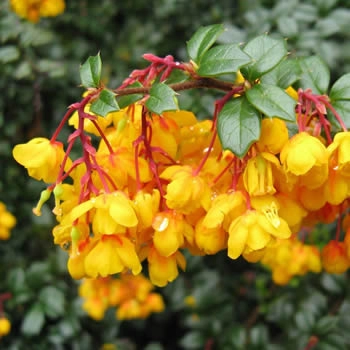
Pruning Shrubs
The Most Read Shrubs to Prune
- How to Prune Hydrangeas
- How to Prune a Rose Bush
- How to Prune Azaleas
- How to Prune a Lilac Bush
- How to Prune Buddleias - Butterfly Bushes
- How to Prune Forsythia
- How to Prune Weigela
- How to Prune Hebe
- How to Prune Camellia

Pruning Trees and Climbers
The Most Read Trees to Prune
- How to Prune Apple Trees
- Pruning Plum Trees
- Pruning Cherry Trees
- Pruning Olive Trees
- How to Prune a Grape Vine
- Acer Pruning | Pruning Japanese Maple
- How to Prune a Fig Tree
- Pruning Peach Trees
- Pruning Pear Trees
- How to Prune a Plum Tree

